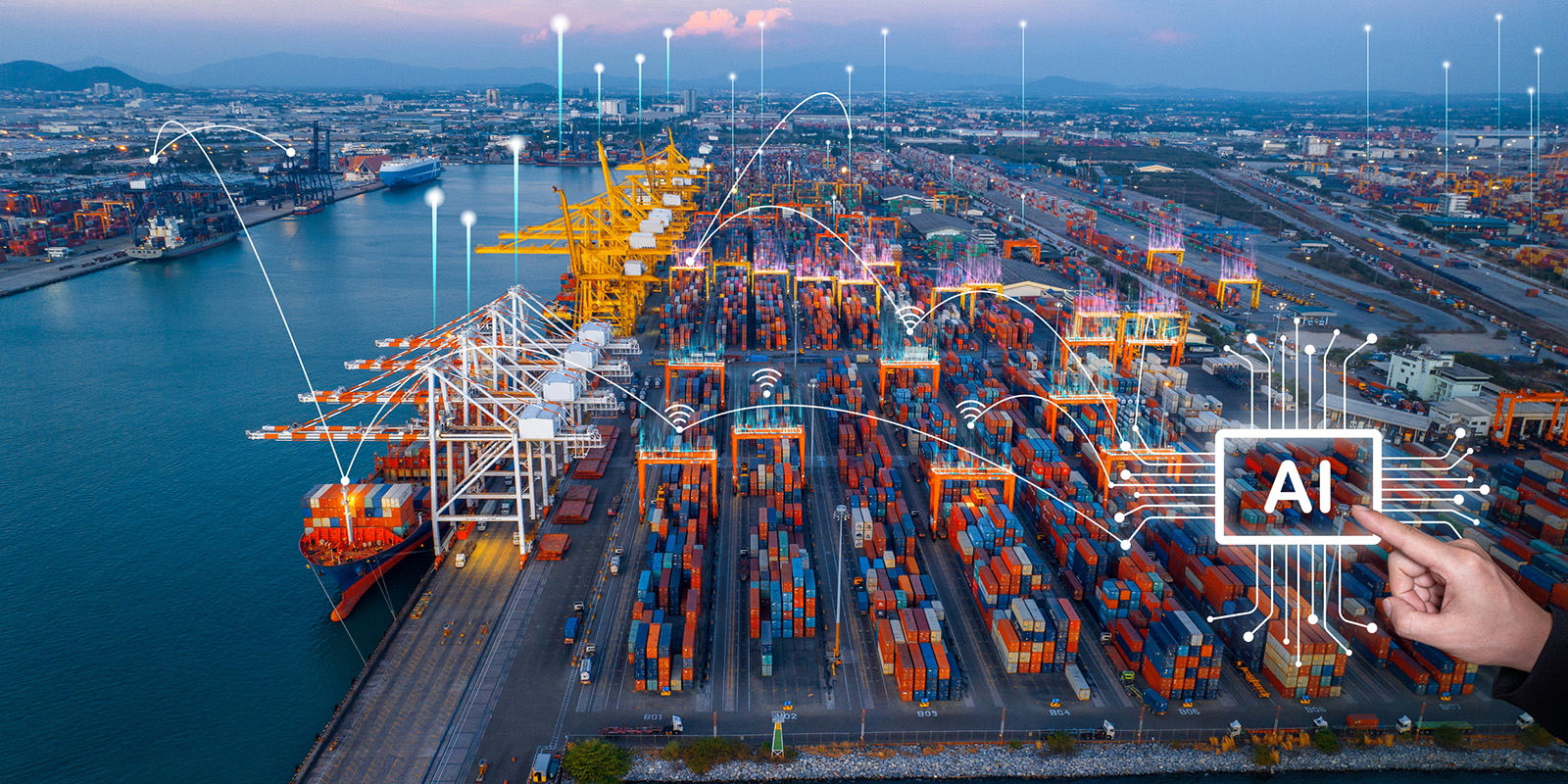AI, Predictive Analytics & Cloud Automation in Seaport Logistics
By: Rich Uphus | December 2, 2024
ARTICLE - Seaport logistics has become more complex than ever in the fast-paced world of global trade. As cargo volumes rise and schedules tighten, ports face growing pressure to enhance efficiency, minimize delays, and optimize every aspect of their operations. Fortunately, emerging technologies like Artificial Intelligence (AI), predictive analytics, and cloud-based systems offer transformative solutions. By integrating these tools, ports improve cargo management, reduce costly downtime, and forecast potential disruptions. The convergence of AI and cloud-based Enterprise Resource Planning (ERP) solutions is proving to be a game-changer for seaport logistics.
The Global Importance of Seaports
Seaports are critical hubs in global trade, handling over 90% of international cargo. According to the International Association of Ports and Harbors (IAPH), ports move approximately 11 billion tons of cargo annually, making them essential to the flow of goods worldwide. However, managing such large-scale operations is a monumental challenge. Port authorities must oversee everything from cargo unloading to storage, customs clearance, and shipment tracking. These processes, if optimized, can avoid significant delays and financial losses, affecting not only the ports themselves but also the broader global supply chain.
Predictive Analytics: A Game-Changer for Port Efficiency
At the heart of the technological revolution in ports is predictive analytics. This powerful tool leverages historical data, machine learning, and statistical algorithms to forecast future events. For seaports, predictive analytics provides critical insights into everything from equipment health to cargo flow, enabling smarter, data-driven decisions that streamline operations.
For example, predictive analytics can anticipate spikes in container traffic, allowing ports to allocate resources—like cranes, trucks, and personnel—more efficiently. Moreover, by analyzing equipment data in real-time, ports can implement predictive maintenance, identifying potential machinery failures before they occur. Instead of relying on fixed maintenance schedules, AI systems predict when equipment will likely malfunction, ensuring timely repairs and minimizing operational disruptions. According to a report by McKinsey & Company, reducing downtime by just 1% can save a large port millions of dollars annually.
Predictive analytics also enhances cargo management. By analyzing previous shipment data, AI can determine the most efficient ways to handle incoming cargo, preventing bottlenecks and optimizing space allocation. This improves overall throughput and reduces the time vessels spend in port—critical in an industry where time is money.
Reducing Downtime: The Financial Impact
Operational downtime remains a costly problem for seaports, with each hour of equipment failure potentially costing between $2,000 and $3,000. For large ports handling millions of tons of cargo, even short delays can lead to severe financial repercussions. Delays ripple through the entire supply chain, disrupting the schedules of shipping companies, manufacturers, and retailers.
By utilizing AI-driven predictive models, ports can address these challenges head-on. For instance, predictive analytics systems can alert operators when key pieces of machinery—like cranes or trucks—need maintenance, preventing unexpected breakdowns. This cuts downtime and ensures operations continue smoothly, even during high-traffic periods. Seaports can operate at peak efficiency by optimizing maintenance schedules and preempting breakdowns, saving time and money.
Forecasting Disruptions: Staying Ahead of the Curve
One of the most critical functions of AI and predictive analytics in port logistics is their ability to forecast potential disruptions. From adverse weather conditions to labor strikes and equipment failures, unexpected events can bring port operations to a halt. By processing vast amounts of data—ranging from weather forecasts to historical shipping patterns—AI systems can predict these disruptions before they happen. Ports can then take proactive measures to minimize delays, such as rescheduling cargo loading or rerouting vessels to alternative docks.
According to ABI Research, ports that embrace AI and predictive analytics could see a 25-30% increase in efficiency by 2030. This is significant in an industry where even slight efficiency improvements translate to substantial cost savings and competitive advantage. Inefficiencies in port operations are estimated to cost the global economy up to $40 billion annually.
AI-Driven Solutions and the Power of Cloud Technology
Seaports generate and rely on massive amounts of data. Every cargo movement, equipment repair, and staffing decision produces information that needs to be processed and acted upon in real-time. This is where cloud-based ERP solutions come into play. These systems integrate all aspects of port operations, from financial management to inventory tracking, into a unified platform. By combining AI and cloud technology, ports can monitor real-time performance and make more informed, data-driven decisions. One such solution that is making waves in the industry is the Harbour Mastery + NetSuite ERP system. This comprehensive platform provides seaports the tools to manage operations seamlessly, from cargo handling to equipment maintenance and financial tracking.
The Harbour Mastery + NetSuite Solution: Transforming Seaport Logistics
Harbour Mastery, in partnership with NetSuite's cloud-based ERP technology, offers a tailored solution designed specifically for seaports. This platform integrates AI-driven predictive analytics, real-time data processing, and seamless department communication. The result? A powerful, data-driven system that optimizes every aspect of port management.
Some of the key benefits of the Harbour Mastery + NetSuite solution include:
-
- Improved Operational Efficiency: By leveraging AI and predictive analytics, ports can allocate resources more effectively, reducing delays and enhancing cargo management.
- Cost Savings: Predictive maintenance minimizes equipment downtime, saving ports from costly repairs and unplanned outages. Optimized cargo handling reduces demurrage fees and accelerates vessel turnaround times, cutting operational costs.
- Enhanced Forecasting: By processing data from multiple sources, the ERP system allows ports to accurately forecast traffic patterns, equipment needs, and potential disruptions—helping them stay one step ahead of operational challenges.
- Real-Time Visibility: The integrated cloud ERP system provides a holistic view of port operations, from financial management to inventory tracking. This real-time visibility helps managers make informed decisions quickly and ensures smooth coordination across departments.
"By integrating AI and cloud technology, Harbour Mastery + NetSuite is delivering a solution that addresses the unique challenges of today's seaport operations," said George Walters, CEO of Harbour Mastery. "This is about more than just keeping the lights on—it's about transforming port logistics into a forward-thinking, data-driven industry that's prepared for the future."
The Path Forward: AI and Cloud ERP Are the Future of Seaport Logistics
The future of seaport logistics lies in AI-driven predictive analytics and cloud-based ERP solutions. By reducing downtime, optimizing cargo management, and forecasting potential disruptions, ports can operate more efficiently and maintain their competitive edge in the global market.
The Harbour Mastery + NetSuite partnership is a prime example of how innovative technology can address the unique challenges of modern seaports, helping them confidently navigate the complexities of the future.
Sources:
- International Association of Ports and Harbors (IAPH): www.iaphworldports.org
- McKinsey & Company: www.mckinsey.com
- ABI Research: www.abiresearch.com
- World Bank: www.worldbank.org
- Port Strategy: www.portstrategy.com




